Bascinet - "dog muzzle"
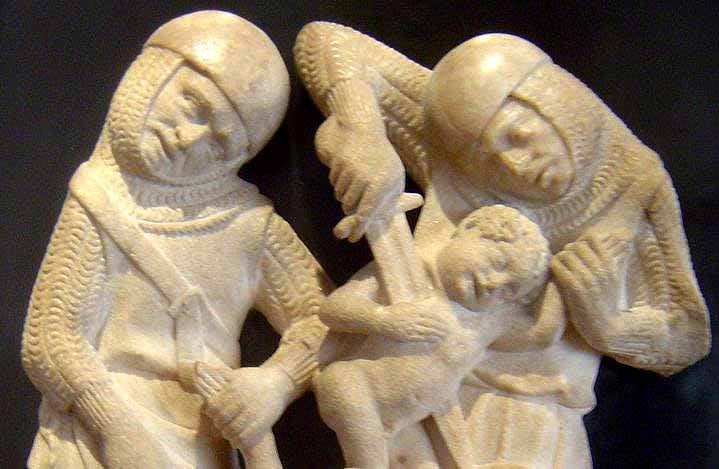
Carved sculpture depicting the biblical scene of beating babies. It very clearly presents the servilera helmets - the predecessors of the bascinet. Near 1300 Antwerp, Belgium. (Museum Mayer van den Berg)
One of the very common helmets of the early Middle Ages was the so-called “helmet-pans” or “helmet-pills”. They had a very simple cylindrical shape (with or without a padded bag) or expanded upwards. But in any case, the top of them was flat or even quite, in extreme cases, have a slightly conical shape. That is why they received such a name that it was enough for them to bend the crook of the nose and it turned out a bucket with a handle, that is, a “pan” typical for that time. These helmets were very comfortable, and most importantly - easy to manufacture. They needed only two parts, that is, a blacksmith could easily make many such helmets! Do not think that they are completely crowded out hemispherical and tapered helmets. Not! But they were simple, which is why they spread widely at the very beginning of the 13th century.
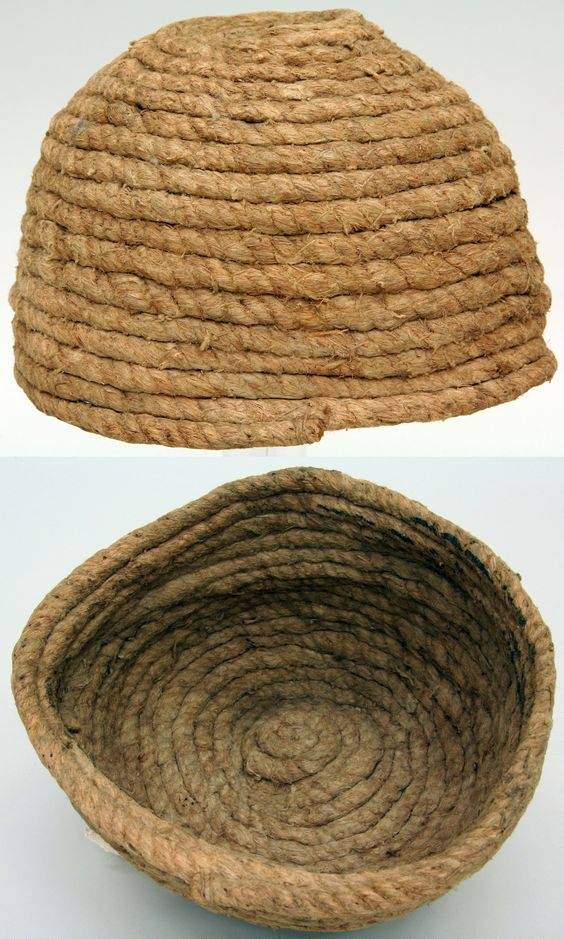
Funny rope servileler XVveka. Germany. (Metropolitan Museum, New York)
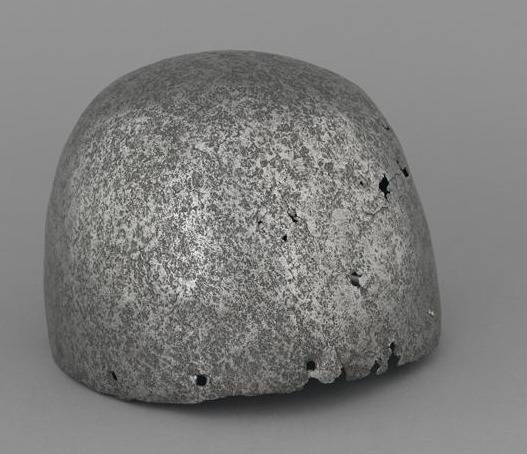
The simplest helmet serviler 1250 - 1300's. (Museum of the Army of France, Paris)
And it was here that their improvement led to the fact that on their basis the so-called “grand slam” appeared. First, somewhere around 1210, a mask covering the face and with slits for the eyes and holes for breathing began to be attached to the cylindrical crown. Then a backplate was added and ... the “grand helmet” was ready! Moreover, a face shield was attached to both conical and hemispherical helmets, but it was more difficult to make them, so they did not receive such wide distribution as flat-top "bucket helmets". In fact, it was an absolute means of protection, because a “big helmet” was put on the head already covered, firstly, with a quilted cap, and, secondly, with a leather-lined chain mail hood. For better fixation on the head, a roller stuffed with horsehair was put on over the chain mail hood, and later, around 1230-1240, another cap with a quilted roller and a stiff collar.
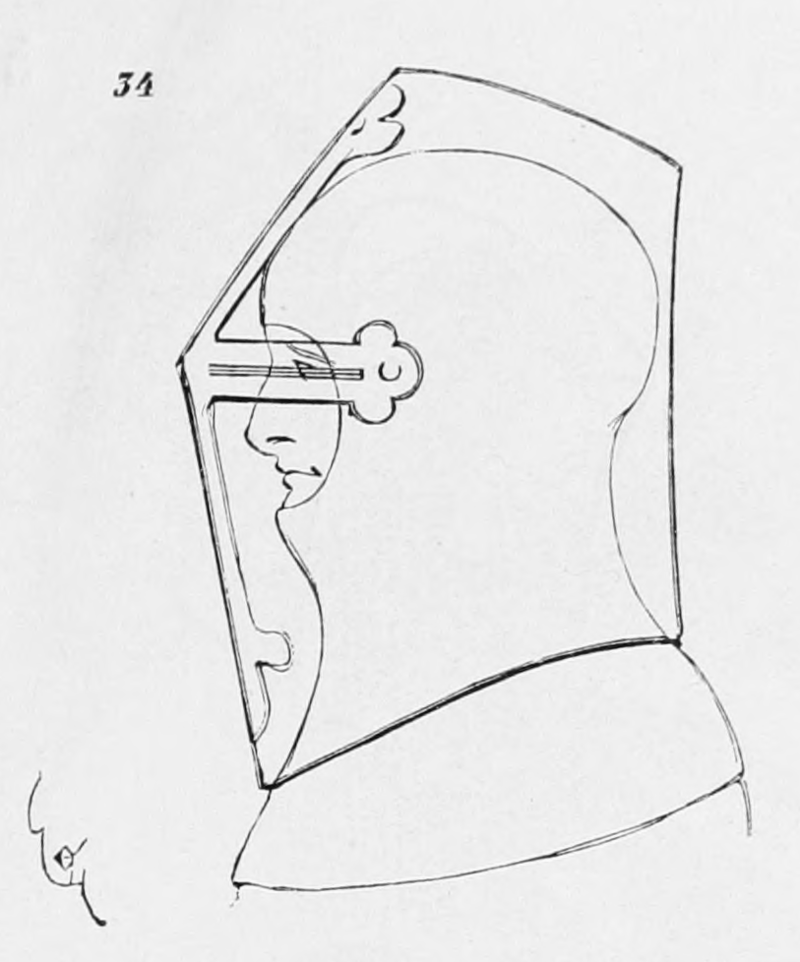
"Grand Slam" of the XIV century, used in tournaments. Illustration from the book of Emmanuel Viollet-le-Duc. It is clearly seen that the space between the nose and the front wall of the helmet is very small, that is, a large amount of force is needed to inhale and exhale to ensure good ventilation of the pre-face space.
However, it immediately became clear that in such a helmet it was difficult to breathe and he had a bad view. That is, to be in it constantly was simply impossible. Therefore, apparently in the event that the "big helmet" was removed from the head, someone thought up to cover the chainmail hood with a metal hemispherical helmet that fits tightly to the head. This helmet received the name of the earwalker. It turned out that it is very convenient in all respects.

Since to our time the early “big helmets” have been preserved very little, this effect of William de Lanvalee, who died in 1217 and was buried in Volkern, the church of Sts. Mary's Why he was not depicted with an open face and a helmet lying under his head is unknown. It is possible that there was no face there, or rather, nothing was left of him, and it was considered a sin to depict him "by memory". Anyway, it is obvious that it was very hard to be in such a helmet.
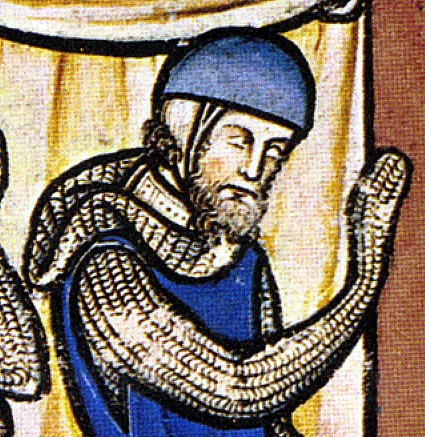
Helmet Servilera from the Bible Macieus 1240 - 1250. (Pierpont Morgan Library, New York)
It is believed that it was he who later gave birth to the helmet bascinet, and at first they were common on the continent: in Germany and in France, and in England they practically did not meet.
Heraldry researcher Stefan Slater (Slater, S. Heraldry. Illustrated Encyclopedia. Second edition, revised and augmented / Translated by I. Zhilinskaya. M .: Eksmo, 2006.), Summarizing the materials on the “big helmet” and helmet-basquette, pointed to their close relationship. In his opinion, the bascinet tight to the head was created precisely in order to be worn under the “big helmet” in such a way that the knights had to protect two whole layers of wrought iron instead of one. At the same time, when the knight put these two helmets on top of each other, a special quilted fabric was laid between them, or its function was performed by the “big helmet” lining. Thus, we can talk about another direction of head protection, namely, the development of helmet-cap comforters, which in turn turn into “external wearing” helmets.
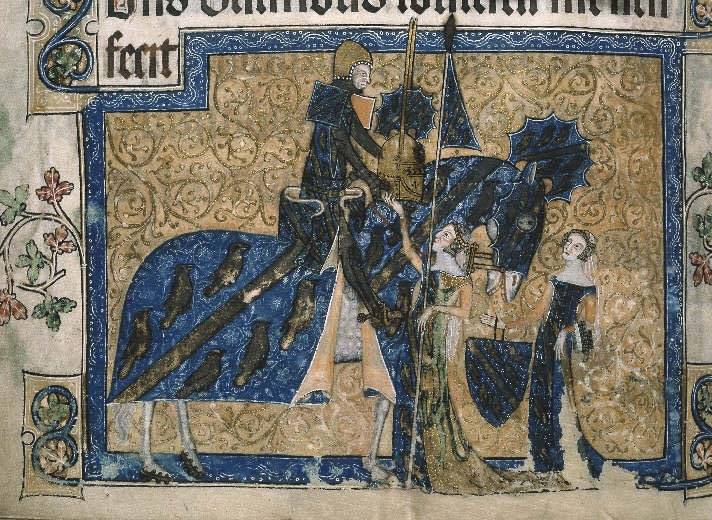
Bascinet Helmet, pictured on the Latrell Psalms page. It depicts Geoffrey Latrell ((1276 - 1345) in full knightly armament and wearing a helmet (most likely copper or gilded) bascinet, the form is clearly such that his “big helmet”, which he holds in his hands, could be put on on top of him.
The English historian Claude Blair notes that in the process of their development, three forms of bascinet appeared:
1. First of all, it is a small rounded helmet with plates on the sides to protect the ears. Often he was portrayed with a mobile visor; its edge fell below the chin, but sometimes it covered only that part of the face that was not protected by a chain mail hood.
2. High conical helmet, arcuate covering the face and continuing almost to the shoulders on the sides and back; sometimes it was equipped with a nose plate, but more often it was equipped with a mobile visor. When the visor happened to be removed, and it was carried out when it was removed, such a helmet was often impossible to distinguish from the “simple helmet” of conical shape.
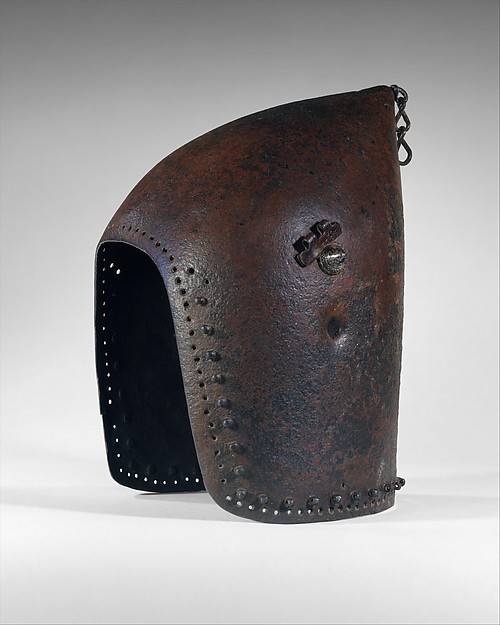
Here is the above bascinet 1375 - 1425's. Weight 2268 France. (Metropolitan Museum, New York)
3. High conical helmet with a flat bottom edge just above the ears. This is the highest version of the conical helmet used from the 10th to the 13th centuries, although it is not known from which helmet it originated, according to Claude Blair. The old conical helmet gradually disappears (judging by the images, during the second half of the 13th century), but both these species are so similar that it is hard to believe that they are not connected with one another or the other. At the same time, all of these helmets also received a chain mail barmitsa, which could be attached to the lower edge of the bascinet, and could also be removed from it.
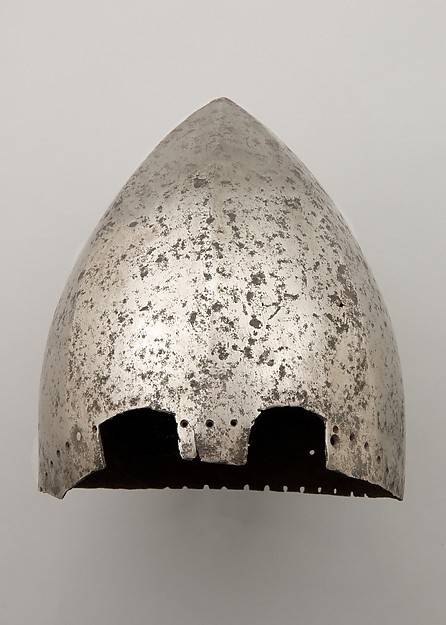
The above bascinet 1325 - 1350's. Weight 1064 Italy. (Metropolitan Museum, New York)
That is, now under the “big helmet”, in addition to a cap and a mail hood, a servilera helmet-cap helmet was worn. But the fact is that he quickly transformed into a helmet bascinet, which was already impossible to wear with a “big helmet”.
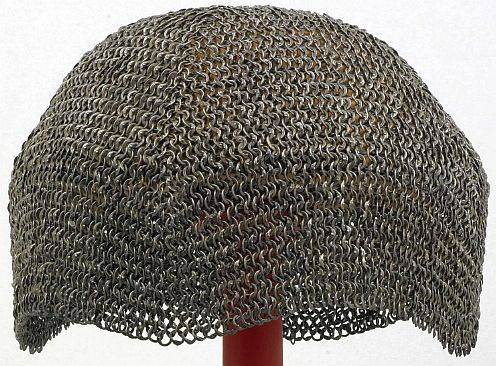
Kolchuzhny cap comforter of the XV - XVI centuries. Weight 0.59 kg. (Wallace Collection)
That is, it is quite possible that the “grand helmet” served to protect the head and face during a spear attack, where the knights galloped one beside the other, forming a “palisade”. But the bascinet was worn more or less constantly, either by removing the visor from it (when it appeared!), Or by lifting it up. True, the tip of a spear on impact on the visor of such a helmet could easily slide off its surface and hook the chainmail around its neck. True, now there were already two layers of chain mail: hood mail and mail silk. But this was not enough. Therefore, on the knightly armor of the first quarter of the XIV century, there is also an all-metal standing collar with a plate armor - bevor, which also protects the upper part of the chest.
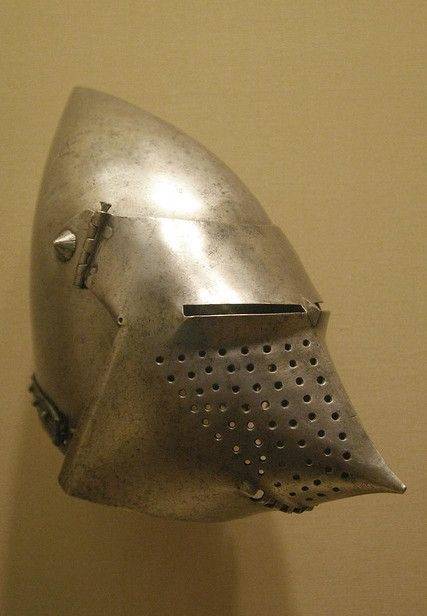
The 1375 Bascinet - 1400 (Metropolitan Museum, New York)
The “Grand Slam”, crowned with a helmet decoration, was now worn over a chainmail hood, servilera or bascinet, with the result that the head of the knight, like the body, was covered with multi-layered armor.
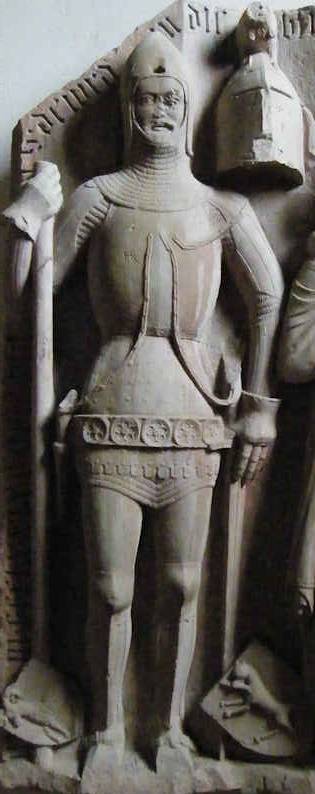
Another example of a multi-layered head booking is Neustadt on Main, Germany, depicting a knight von Reinek who died in 1379. He has a bascinet on his head without a visor, and his “big helmet” is shown next to him, which can also be put on over a bascinet.
Claude Blair, trying in every way to avoid terminological confusion, pointed out that at the very beginning the term “servilera” was a synonym for the word “bascinet” and thus it is often possible to speak about the same subject. It was also used to designate a combat cap and helmet lining, and in one French document, 1309, it is prescribed that each bascinet be equipped with its own servillera. That is, it turns out that the servilier eventually began to be worn already under the bascinet, which became an independent means of protection!
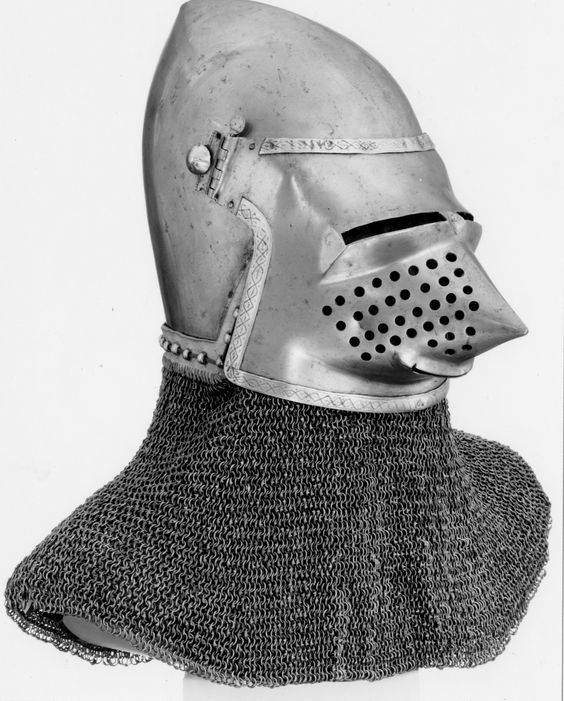
Classic English bascinet with 1380 chain mail - 1400 from Northern Italy. (Royal Arsenal, Leeds, Britain)
The term “bascinet” itself in texts written around 1300 of the year is quite rare, but after it it appears more and more often and so on up to the 1450 year, after which until the 1550 of the year it is mentioned extremely rarely.
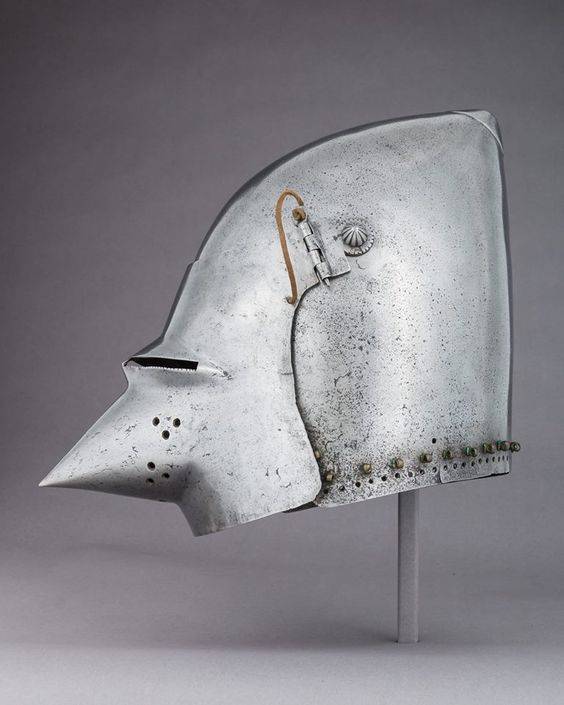
German bascinet 1400 g. Weight 2.37 kg. (Metropolitan Museum, New York)
All of these three types, called Claude Blair, were applied before 1340 - 1350. During the XIV and early XV centuries. in England, a mailless hood without a top, fastened to a bascinet, was usually called aventail, and in France, camail, although both of these words were sometimes used in the same sense in both these countries.
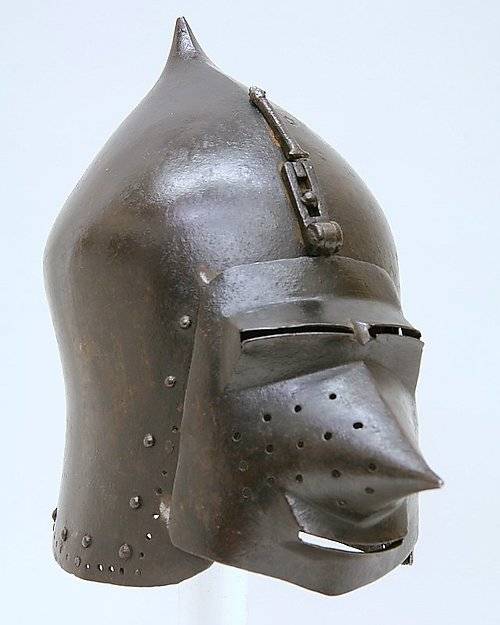
Another bascinet from the Metropolitan Museum in New York. 1420 - 1430 Germany. Weight 2986 g. Attention is drawn to the slot at the level of the mouth and has taken numerous holes in the cone.
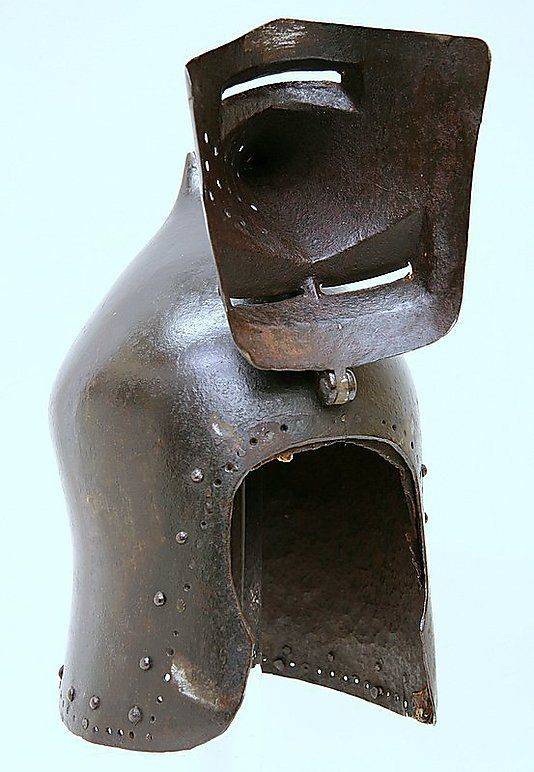
View took from the inside. Obviously, there was enough air to breathe. Rather, thanks to the “dog muzzle”, breathing in it was somewhat easier than in helmets with visor, tightly pressed to the face! (Metropolitan Museum, New York)
The spread of the basquets after 1300 made it fashionable to wear crowns over them, which indicated the rank of a knight, and this is in addition to the heraldic images on his surcoat, shield and horse cloth. One of such crowns in the Cathedral of St. Stanislaus in Krakow, which was accidentally found under a tree in Sandomír, has survived to our time. It consists of four parts with only four teeth in the form of “fleur-de-lis” - the heraldic lily of the French royal house, each of which was decorated with 65 semi-precious stones.
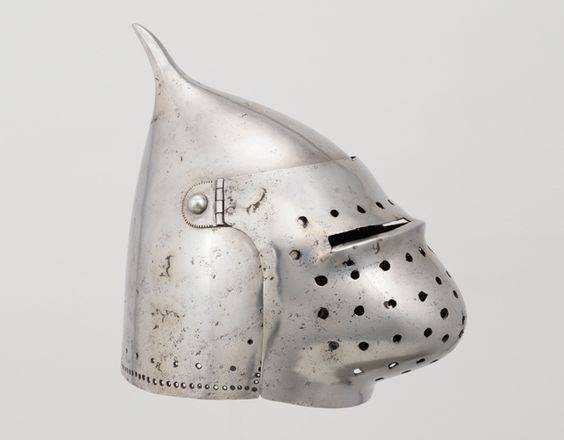
A very funny "lite" bascinet from the Paris Army Museum. 1420 - 1430 Weight 1,78 kg.
The fact that the cost of such jewelery was exceptionally high is exemplified by the example of the baszinet crown of the king of Castile, made of gold and decorated with precious stones. According to the 1385 Chronicle of the Year, it had a value equal to 20000 francs.
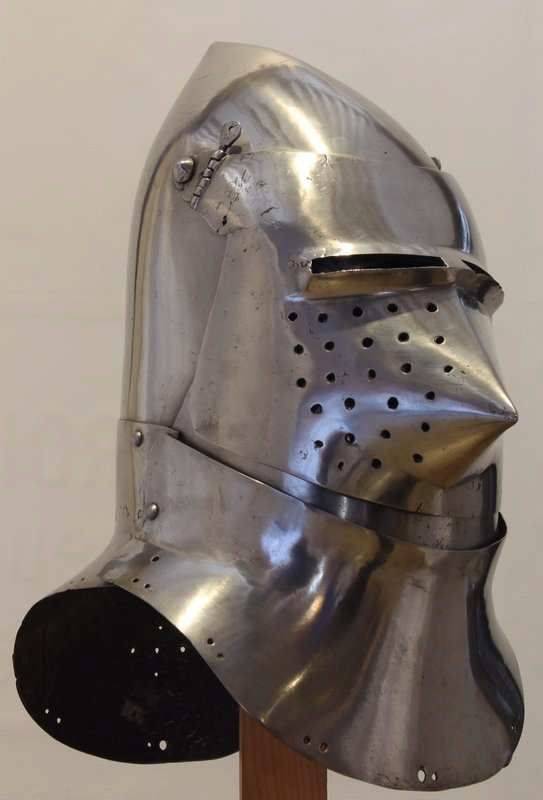
But this is a typical "grand bascinet" or "big bascinet", complemented by the protection of the neck. 1400 - 1420 (Army Museum, Paris)
In this case, the same type of weapons received their local names, which, multiplying, gave rise to the illusion of a great variety, which in fact was not. For example, the same bascinet was called by the English "skull of a dog" or "dog's head", whereas on the continent the German name "Bundhughel" ("dog's helmet") was common, or "pig's snout", which once again emphasized its unusual appearance.
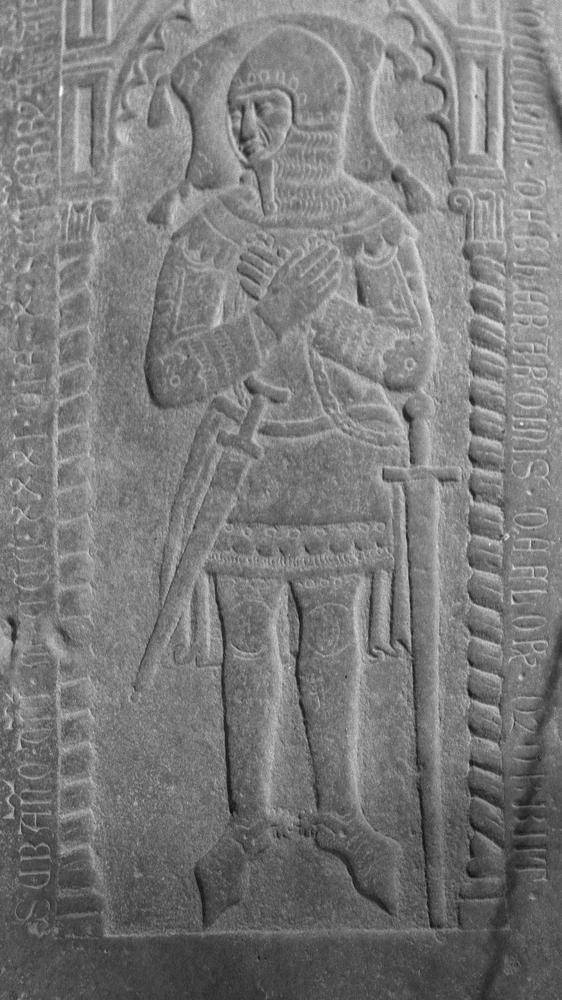
Interestingly, many early types of basquette received a somewhat unusual protective supplement, called bretch. It was a noseband in the form of a narrow band of chain mail with a leather lining, which was a “process” of the barmitz, but at the same time, when it was lifted, it was hooked on the front part of the helmet. The individual Brettashes were all-metal, had the shape of a nose, and were supplied with holes for breathing. Thanks to the Bretash, the “big helmet” could not hit its owner in the nose. That is, he could, of course, but Bretash significantly softened this blow. This form of protection was especially popular in Europe, where one of its models could be a wonderful tombstone with the figure of the Italian knight Gerarduccio de Gerardini from Tuscany, who died in the year 1331 and the buried church of Sts. Apolliano Barberino d'Elsa. He has on his head a typical globular bascinet with a chainmail barmita on a scalloped podboy and a chainmail bretash, from the inside out on a leather lining.
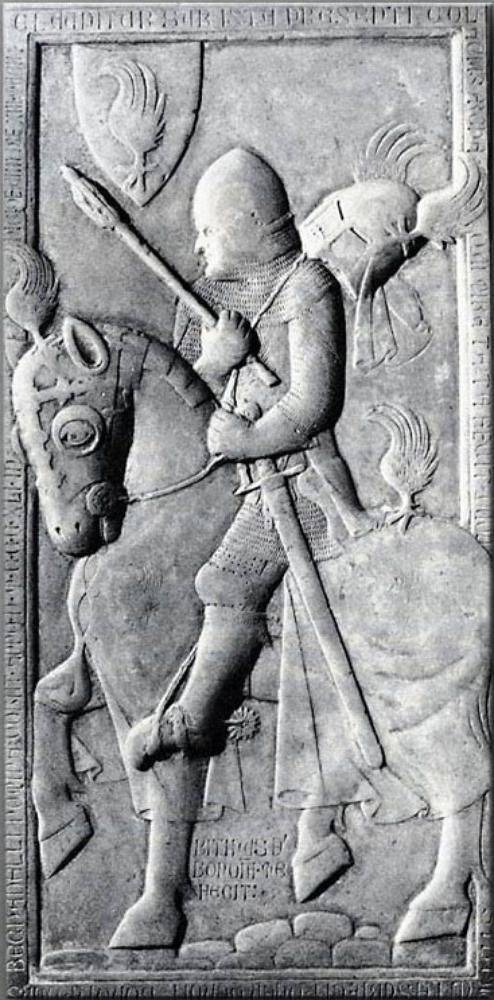
Extremely interesting equestrian performance of Colaccio Bekadelli 1340 Church of Sts. Nicholas and St. Domenica, Imola, Emilia-Romagna, Italy. As you can see, on it he is depicted in a typical bascinet, but his “big helmet”, adorned with a stamped image of a winged eagle paw, is behind him. It can be seen that he really liked his coat of arms, because we see the “paw” on his head, and on the rump of his mine, and two whole paws on his helmet!
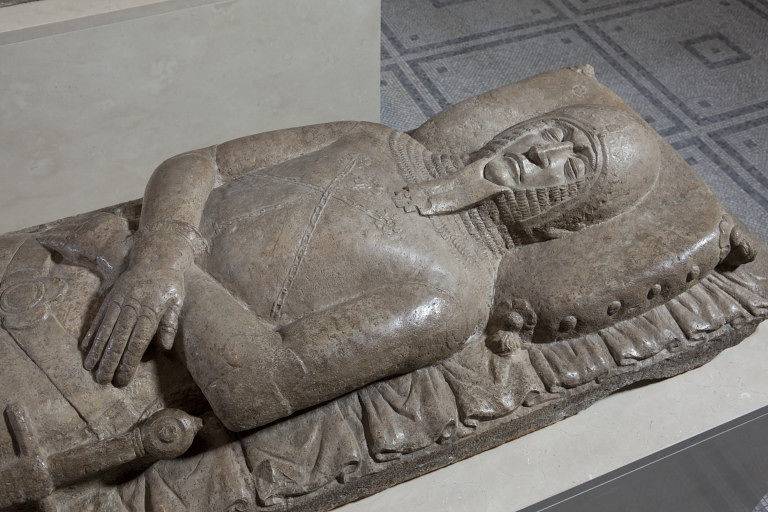
Unknown Venetian Knight 1375 g. Also with a brass bag on a bascinet. Victoria and Albert Museum, Britain.
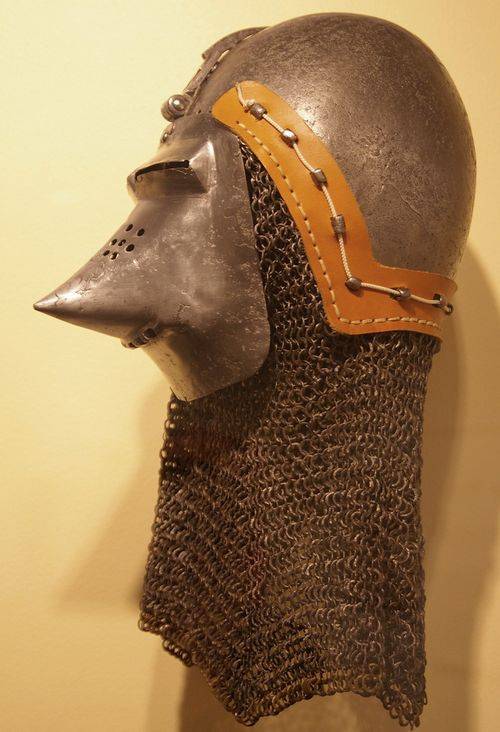
The problem of the early bacquettes was also in the fact that their visor was just a mask hanging on a loop and, in fact, apart from the top edge of the helmet it was no longer supported! The 1380 Bascinet - 1410 Arsenal Higgins, Worchester, Massachusetts.
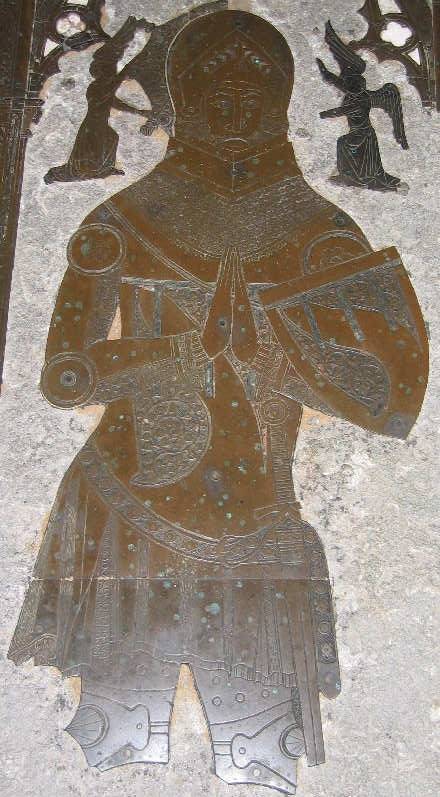
Very interesting image on the tombstone brass (engraved copper or brass plate on the stone tombstone), owned by Hyuga Hastings, mind. 1340, buried in Elsing, Norfolk, St. Mary’s Church. On it is a globular bascinet with visor, chain mail barlets and a lamellar metal neck, with which the helmet itself, however, is not yet connected.
The bascinet proved to be the most common helmet among French patron in the fourteenth century. Among them in the first place were bascinetts of conical shape, and later - with a round-shaped visor, which had numerous openings for breathing. A semi-rigid or very rigid chin could be added to the barmian, and later it began to be attached directly to the bascinet on the rivets.
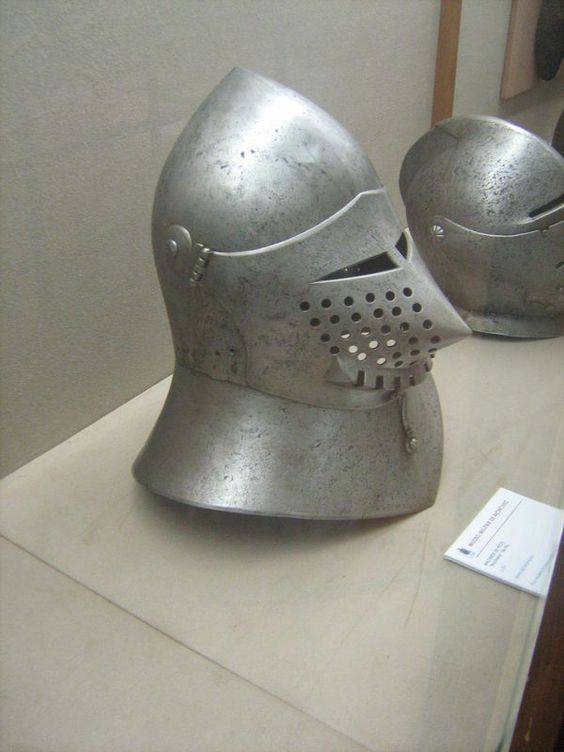
A bascinet with a metal blade. (Army Museum, Barcelona).
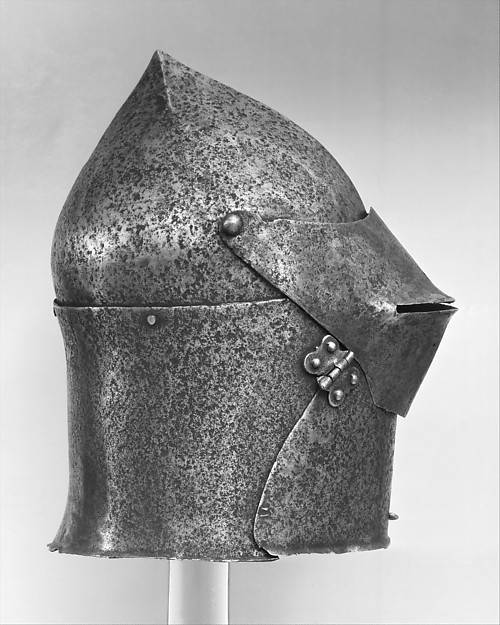
Big Bascinet 1425 - 1450 Italy. Weight 3.912 kg. (Metropolitan Museum, New York)
Thus, a “big bascinet” turned out, which differed from the classic bascinet only by the presence of a solid-forged neck reservation and a large volume of space covered with a visor. At the same time, the helmet bascinet, which had a visor in the shape of a “snout” (“dog's helmet”), became the most popular head protection in the period from 1380 to 1420, and some authors even call "international." Well, with “big bascinet” riveted to him by the bearer and bevor, in the opinion of Ian Heath, also remained after the 1410.
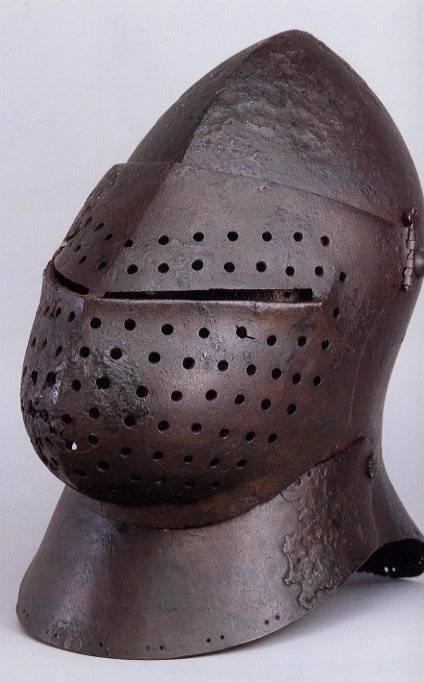
"Big bascinet" XV century. from the museum in Dijon, France.
By the way, the fact that it was very difficult to be in any helmet with full cover of the face was also shown by Soviet cinematographers in one of our first “knightly” films “Black Arrow” (1985), in which King Richard III continually removes helmet and passes it to his squire.
Information